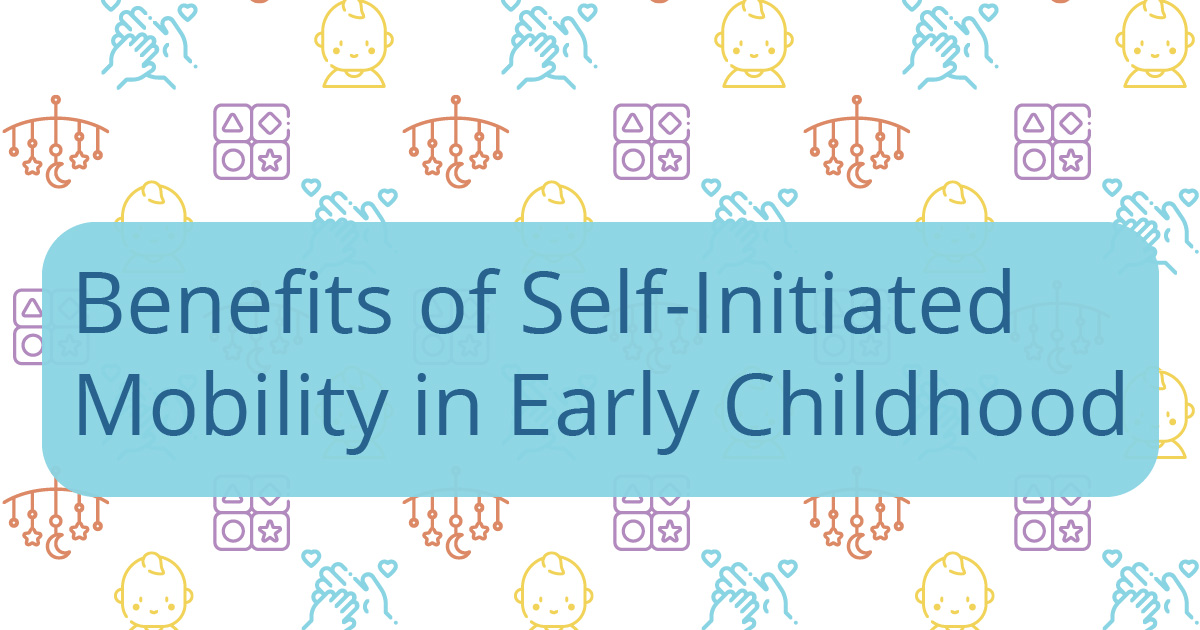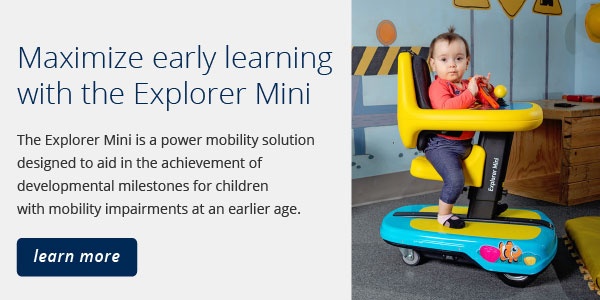Part 2 in our series on early childhood developmental milestones related to mobility. See part 1, part 3, part 4, part 5, part 6, part 7, part 8, part 9, part 10, part 11, and part 12. Learn more about the Explorer Mini here.
Several therapists present courses on the benefits of early self-initiated mobility. We are among them. In this blog series, we are going to begin examining how self-initiated independent movement happens and the developmental milestones that promote independent movement. Self-initiated mobility is defined as movement that is controlled by an individual and may include:
- ambulation (e.g., walking, crawling),
- use of non-powered technology such as prosthetics, walking aids and manual wheelchairs
- use of powered technology such as motorized wheelchairs and battery-operated ride-on toy cars (Logan, Hospodar, Feldner, Huang, & Galloway, 2018).
Powered technology is usually considered when other means of movement have not been successful. The problem with most power mobility devices is they were not truly designed for EARLY. In fact, they are designed for “its really late-but let’s see if we can catch up” and compensate for what has been lost or never gained. Until now we have not been able to observe or examine the full benefits of early self-initiated mobility for young children with disabilities as there has not been a truly appropriate mobility device.
But we do know this, in order to learn, children need SELF-INITIATED exploration:
- If they cannot bring objects to their mouth, their language may be delayed because the oral muscles are not adequately stimulated.
- If they cannot bring an object from one hand to the other and manipulate it around their hand, they do not learn size, shape or texture.
- If they do not crawl or walk or have access to EARLY mobility, they do not learn that their world is a 3-dimensional universe with walls, doors, toys, siblings or parents.
- If they always have to wait until an adult brings them an object curiosity is not fostered.
- Crawling (or self-initiated mobility) provides children opportunities to learn about the environment and social relationships, as well as developing their own self-awareness. (Butler, 1991).
- If children cannot move independently, their visual skills related to spatial relations are delayed.
- If they do not have self-initiated mobility many aspects of development are delayed.
But if we could explore the true sense of early access to self-initiated mobility, we could better understand the potential to impact development and perhaps change the growth and developmental milestones trajectory for young children with mobility impairments.
Icons made by Freepik from www.flaticon.com
 Dr Teresa Plummer, PhD, OTR/L, ATP, CEAS, CAPS
Dr Teresa Plummer, PhD, OTR/L, ATP, CEAS, CAPS
Associate Professor in the School of Occupational Therapy at Belmont University
Dr Teresa Plummer, PhD, OTR/L, ATP, CEAS, CAPS is an Associate Professor in the School of Occupational Therapy at Belmont University in Nashville, TN. She has over 40 yrs of OT experience and 20 in the area of Assistive Technology. She is a member of the International Society of Wheelchair Providers, and the Clinicians Task Force. She is a reviewer for American Journal of OT and guest reviewer for many other journals. She has presented internationally, nationally and regionally particularly in the area of pediatric power mobility. She has authored journal articles and textbook chapters in the area of OT and pediatric mobility and access.

